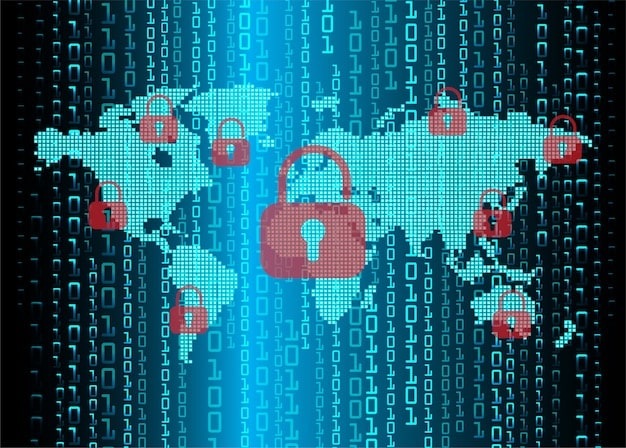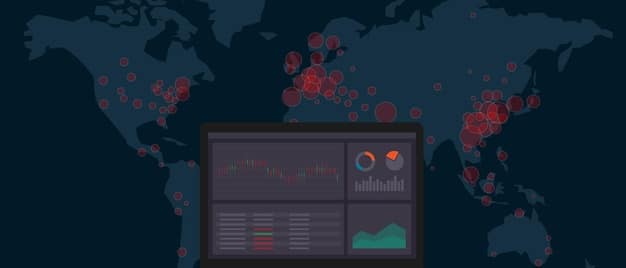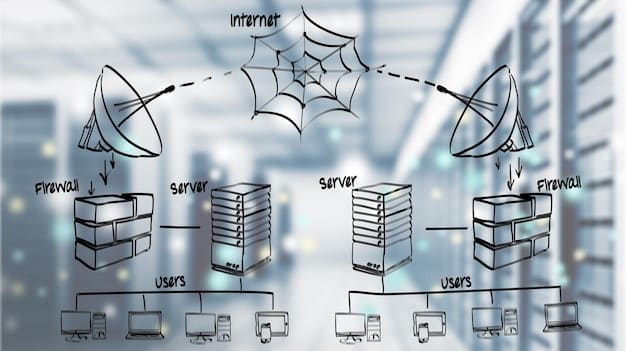Ransomware Attacks Up 15% in US: Protect Your Business Data

Ransomware attacks in the US have surged by 15%, underscoring the urgent need for businesses to implement robust cybersecurity measures, including employee training, advanced threat detection, and regularly updated backup and recovery systems, to safeguard their critical data and ensure business continuity.
The threat of ransomware attacks is escalating in the US, with a concerning 15% increase, leaving businesses vulnerable and at risk of significant data loss and financial setbacks. Understanding the scope and implications of this surge is the first step toward fortifying your defenses and securing your valuable business data.
Understanding the Ransomware Threat Landscape in the US
Ransomware has become a pervasive and damaging form of cybercrime, and its impact on US businesses is growing. This section provides an overview of the current ransomware threat landscape, highlighting the key trends and statistics that underscore the urgency of the situation.
The Rising Tide of Ransomware
Ransomware attacks are becoming more frequent and sophisticated, targeting businesses of all sizes across various industries. The 15% increase in attacks signals a critical need for businesses to reassess and strengthen their cybersecurity posture.
Financial Implications for Businesses
Beyond the immediate ransom demands, ransomware attacks can lead to significant financial losses, including downtime, data recovery costs, legal fees, and reputational damage. These cascading effects can cripple businesses and undermine their long-term viability.

- Cost of Downtime: Ransomware attacks often result in prolonged downtime, disrupting business operations and leading to lost productivity and revenue.
- Data Recovery Expenses: Recovering encrypted data can be a costly and time-consuming process, often requiring specialized expertise and advanced tools.
- Legal and Compliance Costs: Businesses may face legal and compliance costs related to data breaches, including notifying affected customers and complying with regulatory requirements.
In conclusion, understanding the ransomware threat landscape is essential for US businesses to make informed decisions about their cybersecurity investments and strategies. By staying informed about the latest trends and statistics, businesses can better protect themselves from the devastating impact of ransomware attacks.
Identifying Your Business’s Vulnerabilities
Before implementing cybersecurity measures, it’s important to identify the specific vulnerabilities that make your business susceptible to ransomware attacks. This section explores the key areas where businesses often fall short in their security posture.
Outdated Security Measures
Many businesses rely on outdated security measures that are no longer effective against modern ransomware threats. Failing to update software, patch vulnerabilities, and implement advanced threat detection can leave businesses exposed to attack.
Human Error and Phishing Attacks
Human error remains a significant factor in ransomware attacks, with employees often falling victim to phishing emails or other social engineering tactics. Lack of employee training and awareness can create openings for attackers to exploit.
- Phishing Simulations: Conducting regular phishing simulations can help identify employees who are vulnerable to phishing attacks and provide targeted training to improve their awareness.
- Security Awareness Training: Comprehensive security awareness training can educate employees about the latest ransomware threats and best practices for avoiding them.
- Multi-Factor Authentication (MFA): Implementing MFA adds an extra layer of security, making it more difficult for attackers to gain access to sensitive data, even if they obtain employee credentials.
Weak Password Policies
Weak password policies can make it easier for attackers to compromise employee accounts and gain access to critical systems. Enforcing strong password policies and encouraging the use of password managers can help mitigate this risk.
Identifying your business’s vulnerabilities is a critical step in developing a comprehensive ransomware protection strategy. By addressing these weaknesses, businesses can significantly reduce their risk of falling victim to a ransomware attack.
Implementing a Multi-Layered Security Approach
A multi-layered security approach involves implementing multiple layers of security controls to protect your business from ransomware attacks. This section explores the key components of a robust, multi-layered security strategy.
Firewalls and Intrusion Detection Systems
Firewalls and intrusion detection systems can help prevent malicious traffic from entering your network and detect suspicious activity that may indicate a ransomware attack. These tools act as a first line of defense against external threats.
Endpoint Protection and Antivirus Software
Endpoint protection and antivirus software can detect and remove ransomware and other malware from individual devices, preventing them from spreading throughout your network. Regular updates are essential to ensure these tools remain effective.

Data Encryption
Data encryption can protect sensitive data from unauthorized access, even if it falls into the wrong hands. Encrypting data at rest and in transit can significantly reduce the impact of a ransomware attack.
- Full-Disk Encryption: Encrypting entire hard drives can protect data on laptops and desktops, making it unreadable if the device is lost or stolen.
- File-Level Encryption: Encrypting individual files or folders can protect sensitive data stored on servers and shared drives.
- Database Encryption: Encrypting databases can protect sensitive data stored in structured formats, such as customer information or financial records.
Implementing a multi-layered security approach provides a comprehensive defense against ransomware attacks, reducing the likelihood of a successful breach and minimizing the potential damage.
The Importance of Regular Data Backup and Recovery
Regular data backup and recovery is a critical component of any ransomware protection strategy. This section explores the importance of backing up your data and developing a robust recovery plan.
Creating a Comprehensive Backup Strategy
A comprehensive backup strategy should include regular backups of all critical data, stored in a secure location that is isolated from your primary network. This ensures that you can recover your data even if your primary systems are compromised.
Testing Your Recovery Plan
Regularly testing your recovery plan is essential to ensure that it works as expected in the event of a ransomware attack. This involves simulating a ransomware attack and practicing the steps required to restore your data and systems.
Offsite and Cloud Backups
Storing backups offsite or in the cloud provides an additional layer of protection, ensuring that your data remains safe even if your primary location is affected by a disaster or ransomware attack.
Regular data backup and recovery is a vital safeguard against ransomware attacks, enabling you to quickly restore your data and minimize downtime in the event of a breach.
Employee Training and Awareness Programs
Employee training and awareness programs are essential for creating a security-conscious culture within your business. This section explores the key elements of effective employee training programs.
Simulated Phishing Attacks
Simulated phishing attacks can help identify employees who are vulnerable to phishing scams and provide targeted training to improve their awareness. These simulations should be realistic and engaging to be effective.
Security Best Practices
Training should cover security best practices, such as creating strong passwords, avoiding suspicious links and attachments, and reporting suspicious activity. Employees should understand the importance of following these practices to protect the business from ransomware attacks.
- Password Management: Educate employees on the importance of strong, unique passwords and the use of password managers to securely store and manage their credentials.
- Phishing Awareness: Train employees to recognize and avoid phishing emails, including identifying common red flags and reporting suspicious messages.
- Data Handling Procedures: Establish clear procedures for handling sensitive data, including how to store, transmit, and dispose of data securely.
Employee training and awareness programs are a vital component of a comprehensive ransomware protection strategy, empowering employees to become a first line of defense against cyber threats.
Incident Response Planning and Execution
Incident response planning and execution is crucial for minimizing the impact of a ransomware attack and ensuring a swift and effective recovery. This section explores the key elements of an incident response plan.
Developing an Incident Response Plan
An incident response plan should outline the steps to be taken in the event of a ransomware attack, including identifying the scope of the attack, isolating affected systems, and restoring data from backups.
Designating an Incident Response Team
Designating an incident response team with clearly defined roles and responsibilities is essential for coordinating the response to a ransomware attack. This team should include representatives from IT, legal, communications, and management.
Communicating with Stakeholders
Communicating with stakeholders, including employees, customers, and regulators, is a critical part of incident response. Transparency and timely communication can help maintain trust and minimize reputational damage.
Incident response planning and execution are essential for minimizing the impact of a ransomware attack and ensuring a swift and effective recovery. A well-defined plan and a well-prepared team can make all the difference in mitigating the damage and restoring normal business operations.
| Key Point | Brief Description |
|---|---|
| 🚨 Rising Attacks | Ransomware attacks in the US have increased by 15%. |
| 🛡️ Multi-Layered Security | Implement firewalls, antivirus, and data encryption. |
| 💾 Data Backup | Regularly back up data and test recovery plans for quick restoration. |
| 🧑💻 Employee Training | Educate employees about phishing and security best practices. |
Frequently Asked Questions (FAQ)
▼
Ransomware is a type of malware that encrypts a victim’s files, rendering them inaccessible, and demands a ransom payment to restore access. It often spreads through phishing emails or malicious downloads.
▼
Implement a multi-layered security approach, including firewalls, antivirus software, data encryption, and regular data backups. Train employees to recognize and avoid phishing attacks.
▼
Immediately isolate the affected systems, disconnect them from the network, and activate your incident response plan. Contact a cybersecurity expert for assistance in containing and remediating the attack.
▼
The financial implications can be significant, including ransom payments, data recovery costs, downtime, legal fees, and reputational damage. These costs can cripple businesses, especially small and medium-sized enterprises.
▼
Employee training is crucial. Human error is a significant factor in ransomware attacks. Training programs can educate employees about the latest threats and best practices, turning them into a first line of defense.
Conclusion
In conclusion, with ransomware attacks on the rise in the US, implementing robust cybersecurity measures is no longer optional but a necessity for protecting your business data and ensuring continuity. By understanding the threat landscape, identifying vulnerabilities, and adopting a multi-layered security approach, businesses can significantly reduce their risk and safeguard their valuable assets.





